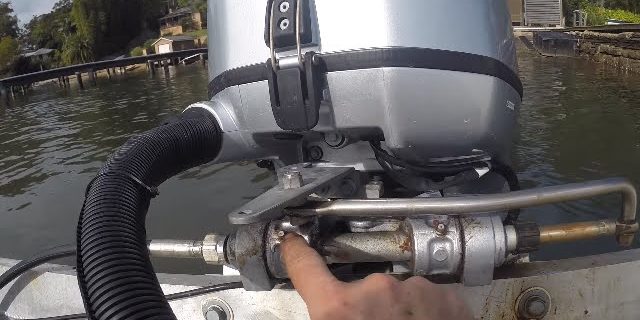What happens if you suddenly lose steering control while underway in your boat? The result is not good, and its severity depends on a couple of factors:
- What type of steering (cable and pulley, cable, hydraulic, electronic)
- What type of boat (outboard, stern drive, inboard)

Inspecting the nut at the end of the steering cable (shown) and the arm on the engine are critical to an uneventful voyage.
Loss of control could be either sudden (cable or hose break, linkage break or disconnection or gradual, e.g., hydraulic fitting leak). Gradual steering failure gives you more time in which to troubleshoot and repair before steering control is completely lost. Sudden loss is dangerous and can result in loss of critical maneuverability or ejection of the skipper and crew.
During steering failure, twin counter-rotating outboards will normally drive somewhat straight until you can reduce speed, but a single outboard under steering failure will usually swing rapidly to starboard and put the boat in a tight starboard turn, usually ejecting the skipper and crew. If ejection is accompanied by failure to use a kill switch, steering failure can result in a circling boat and injury or death.
Inspect before you leave the dock
It is a good idea to check your steering system every time before you leave the dock for damaged cables, missing or loose linkage nuts and bolts, or leaking fluid. A tight or binding steering system puts unreasonable stress on all components and invites a failure. Grease any zerk fittings in the steering system with marine grease. Disconnect the linkage and make sure that the pivot tube (outboard) is not stiff; grease the zerk fittings that serve the pivot tube as well.
Never use a plain nut on a steering component. A ny-lok nut is good; a clevis pin with washer and cotter pin is better.
It is also good to carry a few spares and tools for repairing your type of steering system while on the water. These may include nuts and bolts, hose clamps, hose unions and fluid.
Another linkage to add to your check is the shift linkage. If this becomes disconnected, you will be immobilized until you fix it.
Emergency steering

A long-handled object lashed to the outboard cowling can get you home, avoiding the delay and expense of calling for a tow in the event of steering failure.
If you do experience a steering failure, there are several strategies to consider, depending on your boat type and what you have available:
- Hydraulic steering: temporarily tape over leaking hoses or fittings and refill the reservoir as needed.
- Twin engines: Steer using throttles and/or trim tabs.
- All boats: deploy a sea anchor on a bridle and steer by pulling on the bridle.
- All boats: lash a long-handled net, boat hook, or similar item to the engine cowling as a makeshift tiller.
None of these things work perfectly, which only serves to emphasize the importance of regular inspections and accessibility to critical steering components.







